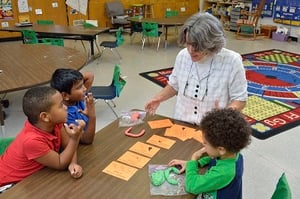 |
| Engineering = hands-on play in a framework |
When our son was three, he would spend hours playing with wooden blocks, making a highway for toy cars, a pen for toy animals, or just the highest tower he could stack. We didn’t think of it this way, but he was engineering.
Early childhood educators have always recognized how building with blocks (and similar hands-on activities) help children develop motor skills while at the same time exercising their creativity. But these activities can also be framed as authentic engineering. That’s something the EiE curriculum team is working on right now: a framework for preschool engineering.
Want to see what a sample lesson from our preschool engineering curriculum Wee Engineer looks like?
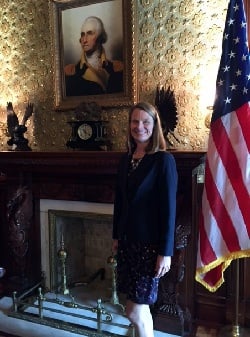 |
| EiE director Christine Cunningham at the White House Early STEM event |
In 2016, the Obama administration called (loudly) for more attention to early STEM education. But acting on this charge will be a challenge for preschool programs, because research-tested preschool engineering curricula are rare. In fact, the Committee on K-12 Engineering Education's report on the state of U.S. engineering education identified exactly one as being of relevance: the NSF-funded PreK–1 Young Scientist Series.
Clearly, preschools need more options. When EiE director Christine Cunningham attended the White House's first-ever Symposium on Early STEM Learning this past spring, we were already at work creating an independently funded, inquiry-based curriculum called Wee Engineer.
Steps That Structure Engineering
 |
| Our PreK-K team meetings are very hands-on! |
For the past nine months, our curriculum development team has been researching, consulting with early childhood experts, brainstorming, creating, and testing. One of the first challenges was to create an age-appropriate engineering design process (EDP)—a set of steps that help to structure the work of engineering.
Maybe this seems like an odd place to start—by developing a process for young learners to follow. Couldn’t we just get right down the business of thinking up engaging engineering activities?
In a word, no! Following a process is what working engineers do—and working like real engineers brings benefits for young children. “An EDP prompts children to think in structured ways,” says EiE curriculum developer Katy Laguzza. “Preschool-aged children are already pretty good at making things, but an EDP will give them the language to think about problem solving while they are making something: ‘What will I make? What do I want it to do? What materials work best?’ This process—thinking about the way you work—builds confidence and empowerment.”
Following a process is not an exotic idea for preschoolers: after all, that’s what they do each time they transition from blocks to circle time, or wash their hands, or line up to go outside. “Preschool teachers are always teaching processes to help kids understand what they’re supposed to do,” Laguzza notes. “We think an age-appropriate EDP will help kids understand that problem solving is also a process with steps you can follow.”
Simple Steps for Early Learners
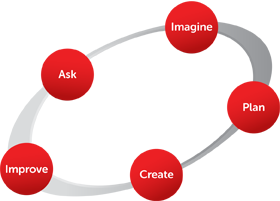 |
| EiE’s five-step EDP. |
Working engineers use many different kinds of engineering design processes, and they can have different numbers of steps—sometimes many steps! When we first developed the Engineering is Elementary curriculum for grades 1–5, we knew we would need an age-appropriate engineering design process (EDP) as a learning scaffold. We settled on “five” as the perfect number of steps (ASK, IMAGINE, PLAN, CREATE, IMPROVE) because the elementary teachers we consulted on the matter told us young students can easily remember as many steps as there are fingers on one hand.
For preschool students, most of whom are not yet reading, our team thought a simpler three-step process was needed. Why three? Research shows that things that come in threes are memorable. Three is a story arc—“beginning, middle, end.” Three is also the smallest number of things you need to create a pattern. And young children are already familiar with “the power of three” in children’s stories (Three Little Pigs), songs ("Three Blind Mice"), and slogans (“Stop, Look, and Listen”).
Design Matters
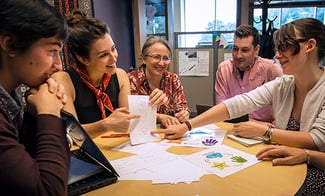 |
| Brainstorming an age-appropriate EDP. |
Using the five-step Engineering is Elementary Engineering Design Process as a starting place, the team concluded that the first two steps (ASK, IMAGINE) could be combined and expressed in a single concept, and so could the second two steps (PLAN, CREATE).
Here’s our working draft of a preschool EDP
- Explore (Find out more)
- Create (Try an idea)
- Improve (Make it better)
We considered how this EDP should be presented not just pedagogically, but visually. Should we use arrows going in a circle, like the five-step Engineering Design Process, to show that the “Improve” step makes engineering a cyclical process?
“We’ve seen in elementary classrooms that when kids move through the five steps, they don’t really focus on the cyclical nature of engineering,” Laguzza says. “We concluded that for younger children, talking about engineering as a cycle was probably not important; the most important thing was for them to understand that problem solving is a process. A linear representation of the EDP is the clearest way to express that.”
Three Steps to Engineering Design
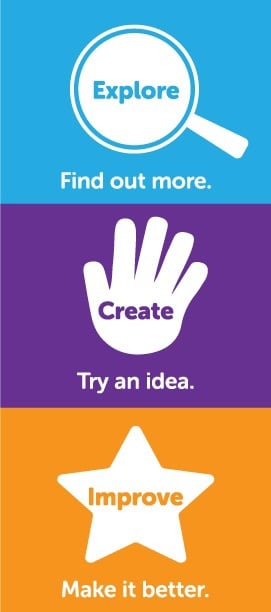 |
| We’ll pilot test this PreK EDP this fall. |
There were more decisions: Should the three steps be shown in a line going left to right? As a vertical stack? “Our draft EDP contains metacognitive (conceptual) words like ‘explore’ and ‘improve’ that may be new for students, but also explanatory phrases—‘find out more,’ ’try an idea,’ ‘make it better’—which use vocabulary words most preschoolers will understand,” Laguzza says. “When we arranged the three steps from right to left, we ended up with two rows of words to read. That was confusing to grownups, not just kids! Arranging the three steps vertically avoids that problem.”
The team also chose symbols to represent each step, because many preschoolers don’t yet read. They picked a simple, blocky style, typical of preschool illustrations, and colors that are easy to differentiate even for readers with the most common types of colorblindness.
“We imagine teachers using the three EDP blocks in a variety of ways,” Laguzza says. “You could present the entire EDP as a large poster, or use it as a tabletop pathway that you move a token along as you accomplish each step. Or teachers might cut the series apart into three separate blocks and place them in different locations: for example putting “Explore: Find out more” on the materials exploration table. There’s lots of room to experiment with the best ways to help children engage with the EDP.”
Pilot Tests Ahead!
To date, the curriculum team has created two preschool activities: Engineering noisemakers that make different sounds and engineering scoops for digging up buried treasure in the sand. Earlier this summer, we brought in a group of preschool and Pre-K educators for a focus group; they tried the activities and gave us valuable feedback.
This fall, we’ll be conducting pilot tests at two Boston-area programs that serve children ages 3–5. There will be lots of playful materials exploration, and we’ve even written a song to help young children remember the Engineering Design Process, to the tune of “Farmer in the Dell.”
We have lots of questions about our proposed three-step Engineering Design Process, and we hope these and other pilot tests will help to answer them. For example, Explore, Create, and Improve represent abstract concepts as opposed to literal things. Preschool students probably don’t know these words. Can they readily learn them? (Learning new vocabulary is a good goal, but at the same time, we want to avoid creating a cognitive load.) Once kids have done some engineering, will they start to use these words? How? To describe their problem-solving processes? Will they apply the words to other activities?
We have questions for teachers as well as students. Do preschool educators find the EDP to be a helpful scaffold? What words do THEY use when they speak about engineering with their students? We’ll be conducting qualitative assessments as part of these pilot tests—observing how kids respond to the activities and asking teachers to report on student outcomes. We welcome your comments and questions.









